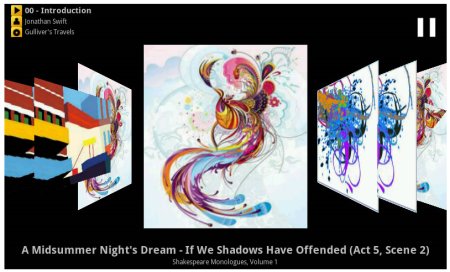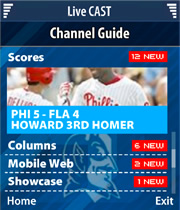Wind River Platform for Android gains full Flash Player
Aug 4, 2010 — by Eric Brown — from the LinuxDevices Archive — 1 viewsWind River announced that it is participating in Adobe's Open Screen Project and has become a worldwide scaling partner for Adobe Flash software. Wind River will license, distribute, integrate, and support Adobe Flash Player 10.x, Adobe AIR 2.x, and Flash Lite 4.x across its “Internet-facing software platforms,” including Wind River Platform for Android.
With its participation in the Open Screen Project, Wind River is now one of eight global "scaling partners" entrusted by Adobe to offer licenses for Flash-related products directly to companies worldwide, says the company.
The Adobe-sponsored organization of more than 70 industry partners provides "consistent Internet and rich media experiences across the broadest possible range of consumer electronics," says Wind River (see farther below for more on the Open Screen Project).

UI personalization in Wind River Platform for Android
(Click to enlarge)
The key focus of the collaboration appears to rest on Wind River Platform for Android, which shipped in December with Flash Lite support. Now, with Flash Player 10.1 having been integrated in Android 2.2 ("Froyo"), this full Flash client will soon also be incorporated in Wind River's Android development platform along with AIR, the company says.
Wind River says it will work with customers to integrate Adobe Flash Player 10.1 and AIR with their Android devices, and ensure these implementations are compliant with the Open Screen Project certification test suites. After its initial Android platform integration, the company will add Flash to other "Internet-facing software platforms," says the Intel subsidiary.
Wind River Platform for Android is a commercial version of the Android software development kit, optimized for the Texas Instruments OMAP3x platform. The SDK offers interface extensions, an automated test framework, plus pre-integrated PacketVideo OpenCore, and Red Bend FOTA software, says Wind River.
While the Flash media playback technology needs no introduction, AIR is less widely known. Used for developing rich Internet applications (RIAs) outside the browser, the cross-platform AIR software is equipped with the open source WebKit HTML engine and "SquirrelFish" WebKit JavaScript interpreter for claimed acceleration of application performance.
Open Screen Project background
With its participation in the Open Screen Project, Wind River "will keep Flash open and updatable in its software stack, as well as offer support customers with upgrade services," says the Intel subsidiary.
Flash, however, is not really open in the sense of offering open source licensing like Android, or like most of the other components integrated in Wind River's Linux and Wind River Platform for Android. As such, it has been widely shunned in the desktop Linux world in favor of true open source solutions.
However, with its Open Screen Project, announced in May 2008, Adobe began an outreach program to attract embedded device developers, with a particular focus on getting the attention of Linux and open source developers. Although the Project's primary goal is the standardization around a consistent runtime environment across multiple devices using Flash and Adobe AIR, it was also intended as a fence-mending exercise with the open source world. 
Adobe's carrot was the elimination of licensing fees required to offer Flash clients on embedded devices. In addition, the company released some open device-layer APIs, and removed various restrictions on the use of the SWF (shockwave flash) and FLV (flash video) file formats.
The company also published the Flash Cast protocol, which offers branded experiences across mobile platforms (see FlashCast example at right). Finally, Adobe released the AMF (action message format), which lets Flash applications receive information from remote databases.
The stick, of course, is that despite opening some APIs for easier porting, Flash is still at its core a proprietary format. It's only slightly more open than the Flash-averse iPhone and iPad offered by Apple, which remains a far larger obstacle to the spread of Flash than open source advocates.
Indeed, the Open Screen Project's various carrots — especially the removal of licensing fees — have helped to break down the barriers of resistance to Flash among embedded device developers, despite their general preference for working with open source software. An even larger motivator was the sheer public demand for the media playback format as wireless broadband and fast processor drove more media to mobile devices. Meanwhile, even the desktop Linux world is gradually giving in to the technology.
The arrival this summer on Android 2.2 smartphones, and soon, tablets, has been something of a crowning achievement for Adobe, which now has only Apple blocking its path. According to Adobe, Flash is now available on 98 percent of Internet-enabled desktops, and is expected to run on more than 250 million smartphones by the end of 2012.
Stated Michael Krutz, vice president of worldwide solutions and services at Wind River, "Consumers have become increasingly sophisticated and expect a flawless, consistent experience when viewing rich content on their smartphones, PCs, tablets, TVs or other devices. By licensing and supporting Adobe Flash across our portfolio, Wind River helps device manufacturers avoid the cost and complexity of integrating and certifying Adobe Flash on their own."
Stated Danny Winokur, vice president of the Flash Client Platform at Adobe, "Given their deep mobile and embedded expertise, and reach into a wide range of markets, Wind River will be a great partner and deliver upfront integration, worldwide distribution and support for Flash Player 10.1 and AIR across a wide array of devices."
Availability
Adobe Flash Player 10.1 licenses and support are now available from Wind River, and licenses and support for Adobe AIR will be available following Adobe's introduction of AIR for the embedded and mobile market segments, says the company. More information may be found here.
Adobe's Open Screen Project site may be found here.
This article was originally published on LinuxDevices.com and has been donated to the open source community by QuinStreet Inc. Please visit LinuxToday.com for up-to-date news and articles about Linux and open source.